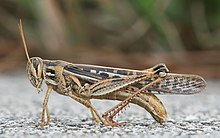
Back جندب Arabic چکیرتکه AZB Balang BAN Lokton BCL ঘাসফড়িং Bengali/Bangla Ceiliog y Gwair CY Sakɔɣu DAG Gɔt DIN Godu DTP ملخ FA
| Grasshoppers | |
|---|---|

| |
| American grasshopper (Schistocerca americana) | |
| Scientific classification | |
| Domain: | Eukaryota |
| Kingdom: | Animalia |
| Phylum: | Arthropoda |
| Class: | Insecta |
| Order: | Orthoptera |
| Suborder: | Caelifera |
| Infraorder: | Acrididea |
| Informal group: | Acridomorpha Dirsh, 1966 |
| Superfamilies | |
Grasshoppers are a group of insects belonging to the suborder Caelifera. They are amongst what are possibly the most ancient living groups of chewing herbivorous insects, dating back to the early Triassic around 250 million years ago.
Grasshoppers are typically ground-dwelling insects with powerful hind legs which allow them to escape from threats by leaping vigorously. Their front legs are shorter and used for grasping food. As hemimetabolous insects, they do not undergo complete metamorphosis; they hatch from an egg into a nymph or "hopper" which undergoes five moults, becoming more similar to the adult insect at each developmental stage.[1] The grasshopper hears through the tympanal organ which can be found in the first segment of the abdomen attached to the thorax; while its sense of vision is in the compound eyes, a change in light intensity is perceived in the simple eyes (ocelli). At high population densities and under certain environmental conditions, some grasshopper species can change colour and behavior and form swarms. Under these circumstances, they are known as locusts.
Grasshoppers are plant-eaters, with a few species at times becoming serious pests of cereals, vegetables and pasture, especially when they swarm in the millions as locusts and destroy crops over wide areas. They protect themselves from predators by camouflage; when detected, many species attempt to startle the predator with a brilliantly coloured wing flash while jumping and (if adult) launching themselves into the air, usually flying for only a short distance. Other species such as the rainbow grasshopper have warning coloration which deters predators. Grasshoppers are affected by parasites and various diseases, and many predatory creatures feed on both nymphs and adults. The eggs are subject to attack by parasitoids and predators. Grasshoppers are diurnal insects, meaning they are most active during the day time.

Grasshoppers have had a long relationship with humans. Swarms of locusts can have devastating effects and cause famine, having done so since Biblical times.[2] Even in smaller numbers, the insects can be serious pests. They are used as food in countries such as Mexico and Indonesia. They feature in art, symbolism and literature. The study of grasshopper species is called acridology.
- ^ "grasshopper | Description, Features, & Species". Encyclopaedia Britannica. Retrieved 29 September 2021.
- ^ Nuwer, Rachel (6 March 2013). "A Plague of Locusts Descends Upon the Holy Land, Just in Time for Passover". Smithsonian Magazine. Retrieved 6 May 2021.